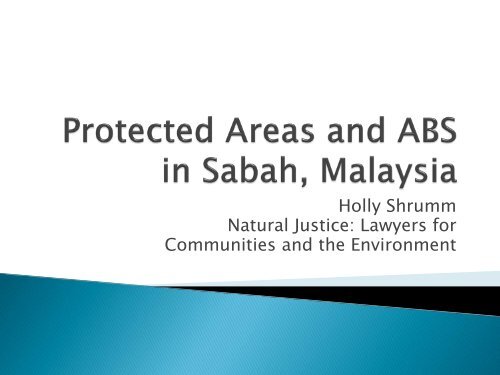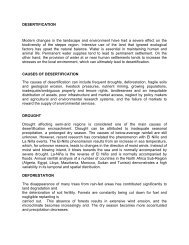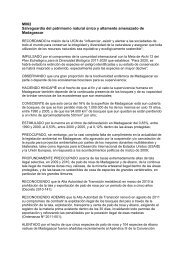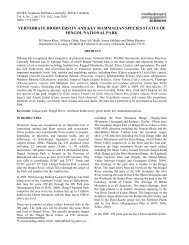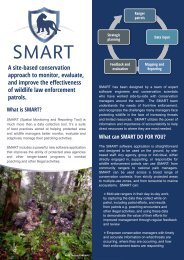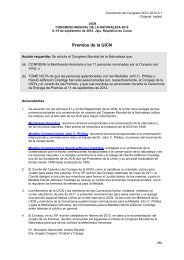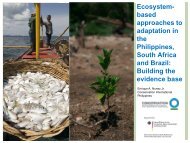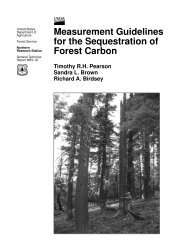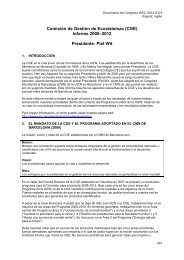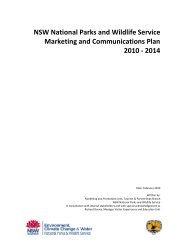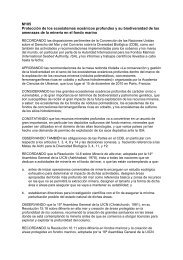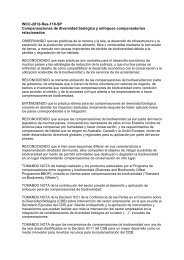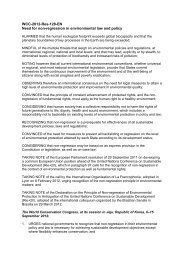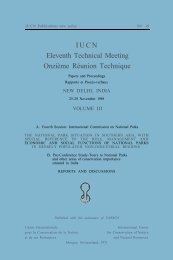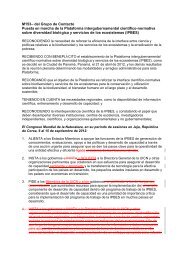Protected Areas and ABS in Sabah, Malaysia - IUCN Portals
Protected Areas and ABS in Sabah, Malaysia - IUCN Portals
Protected Areas and ABS in Sabah, Malaysia - IUCN Portals
Create successful ePaper yourself
Turn your PDF publications into a flip-book with our unique Google optimized e-Paper software.
Holly Shrumm<br />
Natural Justice: Lawyers for<br />
Communities <strong>and</strong> the Environment
• Mount K<strong>in</strong>abalu has arguably the richest flora <strong>in</strong> the world:<br />
nearly 5,000 plant species occurr<strong>in</strong>g <strong>in</strong> an area of about<br />
1,600 km 2 .<br />
• Managed accord<strong>in</strong>g to <strong>IUCN</strong> Category II guidel<strong>in</strong>es as a<br />
fully protected area with an emphasis on strict biodiversity<br />
conservation <strong>and</strong> scientific research. In 2000, K<strong>in</strong>abalu<br />
Park was declared the first UNESCO World Heritage Site <strong>in</strong><br />
<strong>Malaysia</strong>.<br />
• Dozens of Indigenous Dusun communities – very high<br />
diversity of traditional knowledge <strong>and</strong> customary systems<br />
• Mounta<strong>in</strong> is of central spiritual <strong>and</strong> cultural importance to<br />
the Dusun – summit is “gateway to the heavens”
Legal fragmentation of Indigenous peoples’<br />
territories <strong>and</strong> ways of life<br />
Interactions <strong>and</strong> potential conflicts between<br />
customary <strong>and</strong> positive (state / <strong>in</strong>t’l) law<br />
Overarch<strong>in</strong>g state emphasis on resource<br />
extraction <strong>and</strong> exploitation for national<br />
economic development<br />
◦ Often underm<strong>in</strong>es supportive provisions for<br />
Indigenous peoples’ <strong>and</strong> local communities’ rights
The Legal Disaggregation of Reality…
Re-envision<strong>in</strong>g the Law
In context of PAs: overlaps with customary<br />
territories, imposition of restrictions on access<br />
<strong>and</strong> use, “governance” <strong>and</strong> “management” vs.<br />
customary stewardship, etc.<br />
In context of <strong>ABS</strong>: def<strong>in</strong>ition of “community”,<br />
“prior <strong>in</strong>formed consent”, “competent<br />
authority”, etc.
UN Declaration on the Rights of Indigenous Peoples<br />
ITPGRFA (Article 9, Farmers’ Rights)<br />
Convention on Biological Diversity (Articles 8(j) <strong>and</strong> 10(c))<br />
Programme of Work on <strong>Protected</strong> <strong>Areas</strong> (Element 2:<br />
Governance, Participation, Equity, <strong>and</strong> Benefit Shar<strong>in</strong>g)<br />
Akwé: Kon Guidel<strong>in</strong>es on Economic, Cultural, Social <strong>and</strong><br />
Environmental Impact Assessments<br />
Tkarihwaié:ri Code of Ethical Conduct to Ensure Respect for<br />
the Cultural <strong>and</strong> Intellectual Heritage of Indigenous <strong>and</strong> Local<br />
Communities<br />
Nagoya Protocol on <strong>ABS</strong> (Articles 6(2), 7, 12, 21)<br />
Strategic Plan & Aichi Targets (11, 13, 14, 16, 18)<br />
UNESCO Convention for the Safeguard<strong>in</strong>g of the Intangible<br />
Cultural Heritage<br />
• Etc…
Re-envision<strong>in</strong>g the Law
L<strong>and</strong> Ord<strong>in</strong>ance (1930)<br />
Forest Enactment (1968)<br />
Parks Enactment (1984)<br />
Biodiversity Enactment (2000)<br />
• <strong>Sabah</strong> Biodiversity Council<br />
• <strong>Sabah</strong> Biodiversity Centre<br />
<strong>ABS</strong> Regulations (forthcom<strong>in</strong>g)<br />
◦ Federal <strong>ABS</strong> Bill (forthcom<strong>in</strong>g…)<br />
<strong>Sabah</strong> Biodiversity Strategy & Action Plan (2012-<br />
2022, forthcom<strong>in</strong>g)<br />
◦ Others relevant to Indigenous peoples <strong>in</strong>clude Water<br />
Resources Enactment (1998) <strong>and</strong> Wildlife Conservation<br />
Enactment (1997)
Re-envision<strong>in</strong>g the Law
1992-1998<br />
<strong>Sabah</strong> Parks, Universiti Kebangsaan <strong>Malaysia</strong>, <strong>and</strong><br />
WWF-UNESCO-Kew People <strong>and</strong> Plants Initiative<br />
9 Dusun communities around Mt K<strong>in</strong>abalu<br />
Focus on ethnobotanical research,<br />
conservation, environmental education, <strong>and</strong><br />
community development
Communities around Mt K<strong>in</strong>abalu have very high levels<br />
of traditional ethnobotanical knowledge (TEK)<br />
TEK is generally common <strong>and</strong> shared across all villages<br />
<strong>in</strong> K<strong>in</strong>abalu area, although certa<strong>in</strong> plants <strong>and</strong><br />
associated knowledge are specific to certa<strong>in</strong> villages<br />
Traditional knowledge is not <strong>in</strong>herent – it is dependent<br />
upon regular <strong>in</strong>teraction <strong>and</strong> practical application<br />
with<strong>in</strong> the local habitat <strong>and</strong> biodiversity<br />
Traditional knowledge around Mt K<strong>in</strong>abalu is rooted<br />
with<strong>in</strong> the <strong>in</strong>digenous Dusun language, culture, <strong>and</strong><br />
customary resource management practices
Value traditional knowledge as much as other knowledge<br />
Recognize Indigenous peoples’ <strong>and</strong> local communities’<br />
rights to control <strong>and</strong> grant access to their traditional<br />
knowledge, <strong>in</strong>novations <strong>and</strong> practices based on prior<br />
<strong>in</strong>formed consent<br />
Adopt a holistic, equitable, <strong>and</strong> <strong>in</strong>tegrated ecosystem<br />
approach to biodiversity conservation, consistent with the<br />
spiritual <strong>and</strong> cultural values <strong>and</strong> customary susta<strong>in</strong>able<br />
practices of <strong>in</strong>digenous peoples <strong>and</strong> local communities<br />
Foster collaboration between scientists, politicians, <strong>and</strong><br />
community members <strong>in</strong> the “complex process of<br />
biocultural conservation”
Parents <strong>and</strong> elders should take responsibility for teach<strong>in</strong>g<br />
younger generations through practical teach<strong>in</strong>g of use,<br />
process<strong>in</strong>g, <strong>and</strong> application of medic<strong>in</strong>al plants<br />
Establish medic<strong>in</strong>al plant gardens <strong>and</strong> reserves <strong>in</strong> villages<br />
<strong>and</strong> conduct tra<strong>in</strong><strong>in</strong>gs for educational purposes<br />
Document knowledge <strong>in</strong> publications such as plant<br />
manuals, posters, <strong>and</strong> audio-visual materials<br />
Include traditional knowledge <strong>and</strong> customary practices <strong>in</strong><br />
school curricula, engage whole community <strong>in</strong> education<br />
Engage adults through sem<strong>in</strong>ars, workshops, <strong>and</strong><br />
exhibitions
January 2009-June 2010<br />
Two components:<br />
◦ Biocultural Diversity <strong>and</strong> Conservation Learn<strong>in</strong>g<br />
Platform<br />
◦ Identification of potential Indigenous Peoples’ <strong>and</strong><br />
Community Conserved <strong>Areas</strong> (ICCAs)
To support capacity build<strong>in</strong>g <strong>and</strong> raise awareness about <strong>ABS</strong> <strong>and</strong> customary<br />
uses of natural resources, the proposed project will explore the follow<strong>in</strong>g<br />
overarch<strong>in</strong>g themes over three years:<br />
How does communities’ traditional knowledge support customary<br />
susta<strong>in</strong>able uses of natural resources, <strong>and</strong> vice versa<br />
How do communities share their knowledge, <strong>in</strong>novations <strong>and</strong> practices<br />
What are the local dynamics, resources, <strong>and</strong>/or legal <strong>and</strong> policy<br />
frameworks that support or affect communities’ traditional knowledge<br />
Explor<strong>in</strong>g these issues will better enable communities liv<strong>in</strong>g around Mount<br />
K<strong>in</strong>abalu to def<strong>in</strong>e:<br />
To government agencies, how they can engage with <strong>and</strong> support the<br />
communities to cont<strong>in</strong>ue their customary uses of biological diversity <strong>and</strong><br />
protect their traditional knowledge; <strong>and</strong><br />
To commercial <strong>and</strong> non-commercial users, the conditions <strong>and</strong> values<br />
that govern the shar<strong>in</strong>g of their traditional knowledge <strong>and</strong> biodiversity.
Communities: Capacity to provide greater clarity to external<br />
stakeholders about their core values, challenges, priorities, <strong>and</strong><br />
plans relat<strong>in</strong>g to the conservation <strong>and</strong> customary uses of<br />
biodiversity <strong>and</strong> the protection <strong>and</strong> promotion of their traditional<br />
knowledge.<br />
CBOs <strong>and</strong> NGOs: Further development of concepts <strong>and</strong><br />
methodologies for support<strong>in</strong>g communities to engage with<br />
government agencies <strong>and</strong> (non-)commercial researchers<br />
accord<strong>in</strong>g to communities’ terms <strong>and</strong> conditions. One such<br />
methodology may <strong>in</strong>clude, as appropriate, community protocols.<br />
Researchers: Greater clarity about the connections between<br />
customary uses of biodiversity <strong>and</strong> traditional knowledge <strong>and</strong><br />
about the ways communities around Mount K<strong>in</strong>abalu share<br />
knowledge; rights-based dialogues with communities<br />
Government: Community experiences <strong>and</strong> lessons learned<br />
<strong>in</strong>form<strong>in</strong>g related law- <strong>and</strong> policy-mak<strong>in</strong>g processes.<br />
International: Contribute to development of good practice
COMMUNITY PROTOCOLS<br />
• Generally, a community protocol sets out the community’s terms<br />
<strong>and</strong> conditions about how outside agencies can/should/have to<br />
engage with them, accord<strong>in</strong>g to different laws<br />
• These often <strong>in</strong>clude procedures for free, prior <strong>and</strong> <strong>in</strong>formed<br />
consent, access to <strong>in</strong>formation, <strong>and</strong> participation <strong>in</strong> decisionmak<strong>in</strong>g<br />
• Often focus on substantive rights <strong>and</strong> responsibilities such as to<br />
self-determ<strong>in</strong>ation <strong>and</strong> self-governance, customary ownership<br />
over resources, areas <strong>and</strong> territories, ways of life<br />
• There are many different local manifestations… no “template” or<br />
“best practice” (but there may be “good practice” or core<br />
pr<strong>in</strong>ciples)
COMMUNITY PROTOCOLS<br />
• Interface between different legal systems <strong>and</strong><br />
underst<strong>and</strong><strong>in</strong>gs of rights <strong>and</strong> responsibilities<br />
• Supports dialogue <strong>and</strong> constructive collaboration<br />
between different rights-holders <strong>and</strong> duty-bearers –<br />
both aspirational <strong>and</strong> ‘defensive’<br />
• Supports communities to take ownership over the law<br />
<strong>and</strong> decision-mak<strong>in</strong>g processes that impact their ways of<br />
life<br />
• Helps provide clarity <strong>and</strong> legal certa<strong>in</strong>ty to governments,<br />
researchers, <strong>and</strong> other actors
Through community dialogue processes, protocols<br />
often set out, <strong>in</strong>ter alia:<br />
• Who the community is<br />
• Community relationships with l<strong>and</strong><br />
• Local values, priorities, <strong>and</strong> visions<br />
• Local processes <strong>and</strong> terms & conditions for<br />
access<strong>in</strong>g, us<strong>in</strong>g, <strong>and</strong> shar<strong>in</strong>g resources<br />
• Local challenges <strong>and</strong> opportunities<br />
• Rights under customary, national, <strong>and</strong><br />
<strong>in</strong>ternational law<br />
• Calls to other rights-holders <strong>and</strong> duty-bearers to<br />
respect customary laws relat<strong>in</strong>g to actions on<br />
territories <strong>and</strong> to take positive actions where<br />
requested
• Potato Park benefit-shar<strong>in</strong>g agreement amongst<br />
Quechua communities<br />
• Kuna community protocol on traditional knowledge<br />
<strong>and</strong> customary ways of life<br />
• Raika community protocol on livestock keepers’<br />
rights <strong>and</strong> animal genetic resources<br />
• Bushbuckridge Traditional Healers’ Association<br />
biocultural community protocol on traditional<br />
medic<strong>in</strong>al knowledge <strong>and</strong> access to medic<strong>in</strong>al<br />
plants<br />
• Sirkhazi Organic Farmers’ Association community<br />
protocol on customary organic farm<strong>in</strong>g practices<br />
<strong>and</strong> traditional rice varieties<br />
• … <strong>and</strong> many more!
• Preamble<br />
• Not<strong>in</strong>g UNDRIP; <strong>in</strong>separable <strong>in</strong>terrelationship between traditional<br />
knowledge <strong>and</strong> genetic resources; obligation to not restrict<br />
customary use <strong>and</strong> exchange, etc.<br />
• Article 6(2): Access to genetic resources (“established<br />
rights”)<br />
• Article 7: Access to traditional knowledge<br />
• Article 11: Transboundary cooperation<br />
• Article 12: Traditional knowledge associated with genetic<br />
resources<br />
• Parties shall take <strong>in</strong>to consideration customary laws <strong>and</strong> community<br />
protocols <strong>and</strong> procedures<br />
• Parties shall support the development by Indigenous [peoples] <strong>and</strong><br />
local communities, particularly women, of community protocols, etc.<br />
• Parties shall not restrict customary use <strong>and</strong> exchange<br />
• Article 13: Competent national authorities<br />
• Article 21: Awareness rais<strong>in</strong>g … <strong>and</strong> more!
• Community protocols are not necessarily appropriate for<br />
every situation or community<br />
• There is potential for the process to be co-opted by NGOs,<br />
government, or local elites - <strong>in</strong>equities could be further<br />
entrenched<br />
• How to ensure representation of different community<br />
voices, particularly marg<strong>in</strong>alized ones<br />
• One community’s protocol should not <strong>in</strong>terfere with or<br />
underm<strong>in</strong>e other communities’ rights, values, or<br />
endogenous development plans<br />
• Potential for st<strong>and</strong>ardization of someth<strong>in</strong>g that is <strong>in</strong>herently<br />
diverse. What are the pros <strong>and</strong> cons of develop<strong>in</strong>g<br />
guidel<strong>in</strong>es or work<strong>in</strong>g towards legal recognition of<br />
community protocols
• Are be<strong>in</strong>g used to communicate <strong>in</strong> their own voices<br />
how their ways of life are help<strong>in</strong>g conserve <strong>and</strong><br />
susta<strong>in</strong>ably use ecosystems <strong>and</strong> why they should be<br />
supported <strong>in</strong> cont<strong>in</strong>u<strong>in</strong>g to do so<br />
• Are one of many adaptive tools that communities can<br />
use to ensure that legal frameworks <strong>and</strong> mechanisms<br />
such as access <strong>and</strong> benefit shar<strong>in</strong>g are undertaken are<br />
accord<strong>in</strong>g to their rights, values, <strong>and</strong> local priorities<br />
• Help clarify rights <strong>and</strong> responsibilities, provide legal<br />
certa<strong>in</strong>ty to governments, researchers, <strong>and</strong> other<br />
actors, <strong>and</strong> support the conservation <strong>and</strong> susta<strong>in</strong>able<br />
use of biodiversity
Integrated approach to the law<br />
◦ Indigenous peoples’ rights, l<strong>and</strong>, customary<br />
susta<strong>in</strong>able use, traditional knowledge <strong>and</strong><br />
practices, governance <strong>and</strong> management<br />
(stewardship) of natural resources, FPIC, equitable<br />
shar<strong>in</strong>g of benefits<br />
◦ Enabl<strong>in</strong>g flexibility <strong>and</strong> resilience<br />
Address<strong>in</strong>g overlaps <strong>and</strong> conflicts, <strong>and</strong><br />
explor<strong>in</strong>g synergies<br />
◦ How can PA laws <strong>and</strong> <strong>ABS</strong> laws re<strong>in</strong>force Indigenous<br />
peoples’ <strong>and</strong> local communities’ rights<br />
Manag<strong>in</strong>g expectations
Holly Shrumm<br />
holly@naturaljustice.org<br />
www.community-protocols.org


